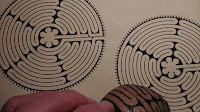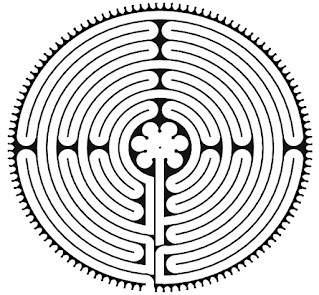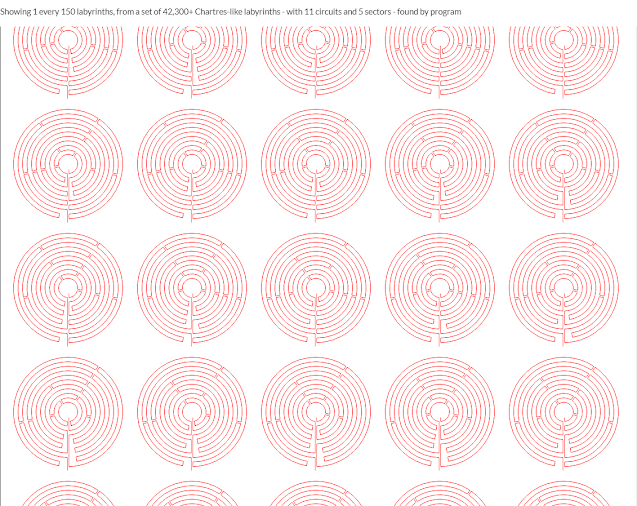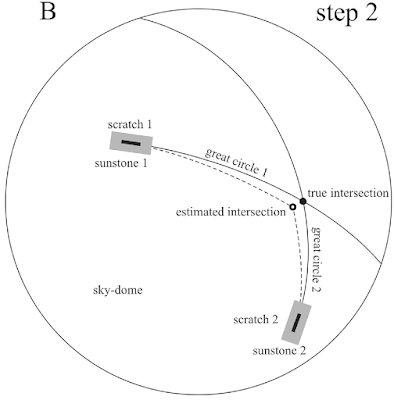Chartres Labyrinth - How many different versions can we create ?
I recently stumbled upon a famous labyrinth in Chartres (France), 12th century.
At first sight, Chartres Labyrinth is amazing. You can't immediately figure out how it works (entrance, exit, path, dead ends, ...). It appears on the paved floor of a religious building. When I was there, the labyrinth was visible under numerous chairs installed on the floor. In those circonstances, you try to follow the path of the labyrinth with your eyes, from a distance. But its concentric circles have a puzzling visual effect. You need to follow it for real, on foot.
After a while, trying to follow the path, avoiding the chairs, it appears that it is not a maze : it has only one path, no dead ends, the entrance and the exit are the same. The specialists use the term "unicursal".
Then a question arise : how many of those labyrinths can you create, following the same design and rules (more or less). If there are more than one solution, why choose this particular one.
This question can take a bit of time.. I guess mathematicians know the answer.
I finally managed (hardship with design softwares...) to produce some variants of the Chartres Labyrinth. There seem to be a lot more...
That could be the subject of a playful hoax : flooding the internet with images of alternative versions of the Chartres Labyrinth, and see if people get caught. Am I just trying that here, on a modest scale ?
Some alternative versions to the Chartres Labyrinth - 4 sectors - 11 circuits
this one has a small dead end and a short straight path that is an island ;
not perfect, because all the surface is not used
This one has 2 small dead ends : we should avoid that
this one contains a closed curved path that is an "island" (in the middle of the down right quarter) :
an example of what we should certainly avoid
this one is better, but still has a small dead end, and a straight island
this one is cool... only 2 small dead ends
but several branches to and from the central trunk
Same version, but without the dead end
Some alternative versions, Chartres-like Labyrinths - 5 sectors - 11 circuits
Not that bad, with five lobes, one dead end here
Two small dead ends, here
Same as before, but without the dead ends,
feels a bit unbalanced ?
Chartres like Labyrinth carved on a Tagua nut - finger labyrinth - hypnoglyph
The same labyrinth as before, carved on a Tagua nut,
to be used as a finger labyrinth
Chartres like Labyrinth drawn on a spherical surface - Potato
Another 5 lobes labyrinth, wrapped onto a potato :
The potato was granted the following version
of a five lobes Chartres-like Labyrinth :
Transposing - Chartres-like Labyrinth - Dodecahedron - 5 sectors - 11 circuits
The same version as before, after a transposition (by different method than for the potato) on the surface of a dodecahedron.
There, each circuit/level is represented by one face of the dodecahedron, among eleven of those. The last face represents the inner and the outer space (center and outside of the Chartres-like labyrinth). Each lobe, and each of the two central paths of the Chartres-like Labyrinth (the entry and arrival at the centre) is represented by a lane in which the path will be followed.
Here a video silently illustrating (or just suggesting) the process of transposition :
Another Chartres like Labyrinth carved on a Tagua nut - finger labyrinth - hypnoglyph
The next 5 lobes, 11 circuits Chartres-like labyrinth I'll make will be this one :
here, carved on a rather angular tagua nut
Computer program generated Chartres-like Labyrinths - javascript - Google Script
June 10, 2020 - I finally wrote my own prototype of a labyrinth generator computer program... it's still imperfect, limited by my incompetence and by some restrictions of the tools i could use (exploration with Google script + rendering in html and javascript). With Google script, despite the 6 minutes limit of running time, the whole exploration is possible for 11 circuits and 5 sectors (with some pruning to avoid disgraceful labyrinths)... but not all of the output via the log (don't know how to write elsewhere, yet). For the rendering, I've some improvements to do...
Some of the 42300 labyrinths found by the computer program
See here, 1 in 150 of the more than 42300 labyrinth the computer program has found. :
42341 labyrinths and a strange technical glitch
See how the technique used (canevas, in html) draws labyrinths that are more "decayed" when drawn farther from the origin.
click on the video below...
More info found : what other people had been doing...
Blogmymaze - Andreas Frei
April 10, 2020 - I find a blog, BLOGMYMAZE ( https://blogmymaze.wordpress.com ), that explores labyrinths, and examines a few cases of "11 circuits, 4 sectors" labyrinths :
Mark Wallinger
April 10, 2020 - Someone has already done this kind of work extensively : in 2013, Mark Wallinger, British artist, has shown 270 distinct labyrinths, one in each of London tube station. There was also a catalog of that; see for instance :
Jo Edkins
May 8, 2020 - An interesting blog compares existing (or having existed) mazes similar to the Chartres Labyrinth. It uses the rectangular transcription to ease the comparison.
Also shows some new designs. http://www.gwydir.demon.co.uk/jo/maze/chartres/index.htm ... this site will soon cease to exist, replaced by www.theedkins.co.uk .... where I was unable to find the same information about mazes... too bad...
Caerdroia - Labyrinthos - Andreas Frei, Hellen Galo, Tristan Smith, Jacques Hébert, ...
May 24, 2020 - Publications n°33 to n°39 of "Caerdroia - the Journal of Mazes & Labyrinths" are available in PDF versions on http://www.labyrinthos.net/digitaldownload.html. Particularly, among many other things, you'll see articles about :
- some variants of Chartres-like labyrinths, explanation from Andreas Frei about his way of cataloging labyrinths, in Caerdroia 39 (links to his website, in German, that seems rather empty) ;
- Amerindian mazes, in Caerdroia 38 ;
- how to create perfect labyrinths (Frei's graph + Hébert notation + 6 canonical labyrinths),by Ellen Galo, in Caerdroia 37 ; this article is also available in the archive of the most requested past articles... so... the subject is clearly interesting to a fair number of people :-)
- Kota labyrinths in southern India, in Caerdroia 36 ;
- how to analyze, design and scale up chartres-like labyrinths, by Andreas Frei, in Caerdroia 35 ;
- a computer program for generating medieval labyrinths, by Tristan Smith, in Caerdoia 35; we read that without enforcing strict enough rules about the properties of the labyrinths, there is ~5 million versions of a 11 circuits / 4 sectors labyrinth. The article links to Tristan Smith's website, where a good number (rapid count : more than 130) of alternative versions of Chartres-like labyrinths have been generated by the program (or with its help), using strict enough rules. The set of rules of Jacques Hébert gives just 20 "canonical labyrinths" that would be (i guess) the most "Chartres-like".
See https://www.otsys.com/~tsmith/daedalus.html ; the images of the labyrinths are in 4 pdfs ;
Also, the definitions corresponding to the rules that the program can respect are here https://www.otsys.com/~tsmith/properties.html (but the article in Caerdrioa is clearer : shows examples)
- a mathematical notation for medieval labyrinths, by Jacques Hébert, in Caerdroia 34;
surprise... Andreas Frei is actually also one of the authors of the blog Blogmymaze (see higher)...
The most requested past articles of Caerdoia are made available in the archive
http://www.labyrinthos.net/caerdroiaarchive.html#CaerdroiaIndex which also has a PDF listing all of the articles from 1980 to 2019... from which i extract this very small selection : the articles that may help in describing and creating variants :
2020/09/13 - another description - with stricter rules - of what should be considered a Chartres-like labyrinth. In http://www.lavigne.dk/labyrinth/e6charst.htm. Chartres-like labyrinths would be made of a combination of those patterns :
to be continued....





























